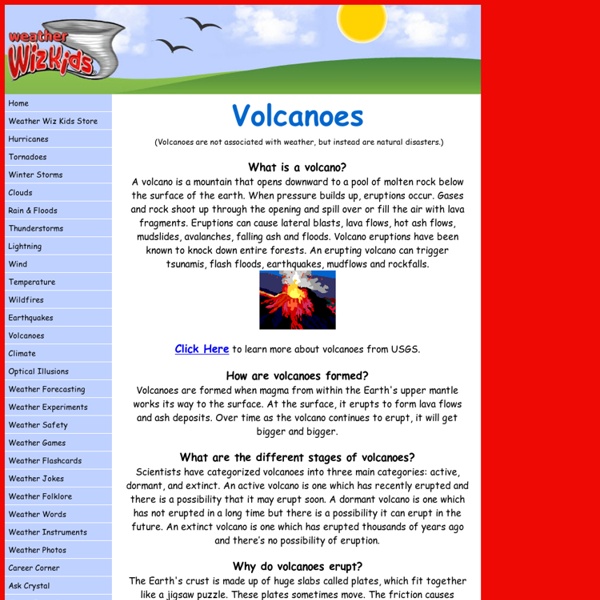Interesting Facts about Volcanoes
Volcanoes are openings in the Earth’s surface. When they are active they can let ash, gas and hot magma escape in sometimes violent and spectacular eruptions. The word volcano originally comes from the name of the Roman god of fire, Vulcan. Volcanoes are usually located where tectonic plates meet.
How many oceans are there?
While there is only one global ocean, the vast body of water that covers 71 percent of the Earth is geographically divided into distinct named regions. The boundaries between these regions have evolved over time for a variety of historical, cultural, geographical, and scientific reasons. Historically, there are four named oceans: the Atlantic, Pacific, Indian, and Arctic. However, most countries - including the United States - now recognize the Southern (Antarctic) as the fifth ocean. The Southern Ocean is the 'newest' named ocean.
Volcano Facts
6. Volcanoes are classified as active, dormant or extinct depending on the amount of volcanic activity happening. 'Active' means there's regular activity, 'dormant' means there's been recent activity but that it's currently quiet and 'extinct', meaning it's been so long since the last eruption that it's unlikely to ever erupt again. 7. 8. 9. 10. 11.
Earth's Oceans
Advertisement. EnchantedLearning.com is a user-supported site. As a bonus, site members have access to a banner-ad-free version of the site, with print-friendly pages.Click here to learn more. (Already a member? EnchantedLearning.comEARTH'S OCEANS: An Introduction Oceans cover about 70% of the Earth's surface. The oceans of Earth are unique in our Solar System. The oceans of Earth serve many functions, especially affecting the weather and temperature. The Earth's oceans are all connected to one another. There are also many seas (smaller branches of an ocean); seas are often partly enclosed by land. WEB LINKS ABOUT OCEAN LIFE, OCEANS AND WATER ON EARTHOcean Animal Printouts from Enchanted Learning. by Jeananda Col Enchanted Learning®Over 35,000 Web PagesSample Pages for Prospective Subscribers, or click below Click to read our Privacy Policy E-mail Copyright ©2000 EnchantedLearning.com ------ How to cite a web page
Volcanoes
Volcanoes Image source: iStockphoto Earthquakes You might not realise but the ground beneath us never stops moving. science Years: 6,7 8 Some mountains are still growing! Did you know that the mountains of New Zealand are still slowly growing higher and that Australia is gradually moving towards the... Science Year: 9 Earthquakes science Years: 6,7 8 Some mountains are still growing! Science Year: 9 Tectonic boundaries: convergent How does the movement of tectonic plates affect the Earth's surface? Sleeping giant awakens on Montserrat The small Caribbean island of Montserrat is home to a volcano that lay dormant for over 300 years until it erupted in 1995. Geography Year: 8 Predicting volcanic eruptions Imagine a volcano erupting kilometres away. Science Years: 6,9 Living next door to a deadly volcano Imagine living in the shadow of a volcano? Wildlife sanctuary in Ngorongoro Crater Deep in Africa's Great Rift Valley is one of the continent's most important wildlife sanctuaries. Geography Years: 4,8 9
Mountain Ranges of the World
Mountain Ranges of the World There are many different mountain ranges in the world, each with its own unique shapes and characteristics. Below are some of the more famous from around the world. The Alps The Andes The Himalaya The Rockies The Appalachians The Rwenzori The Pyrenees The Alborz The Atlas The Urals The Sierra Nevada The Cascades The Alaska Range The Great Dividing Range The Zagros The Karakoram The Hindu Kush The Brooks Range Check out our new Photos page to purchase museum-quality photosby Mountainprofessor.com!
Quick Facts on Icebergs | National Snow and Ice Data Center
Icebergs are commonly found near Antarctica and in the North Atlantic Ocean near Greenland. What is an iceberg? Icebergs are pieces of ice that formed on land and float in an ocean or lake. How do icebergs form, and where do they go? Icebergs form when chunks of ice calve, or break off, from glaciers, ice shelves, or a larger iceberg. When an iceberg reaches warm waters, the new climate attacks it from all sides. Icebergs can develop into a variety of shapes as they break apart. Why are icebergs important? Icebergs pose a danger to ships traversing the North Atlantic and the waters around Antarctica. The International Ice Patrol uses airplanes and radars to track icebergs that float into major shipping lanes. Icebergs can also serve as tools for scientists, who study them to learn more about climate and ocean processes. Scientists test their equipment on a small iceberg during the 2006 IceTrek expedition. Why do scientists study icebergs? How can I learn more? NSIDC ResourcesIceTrek.



